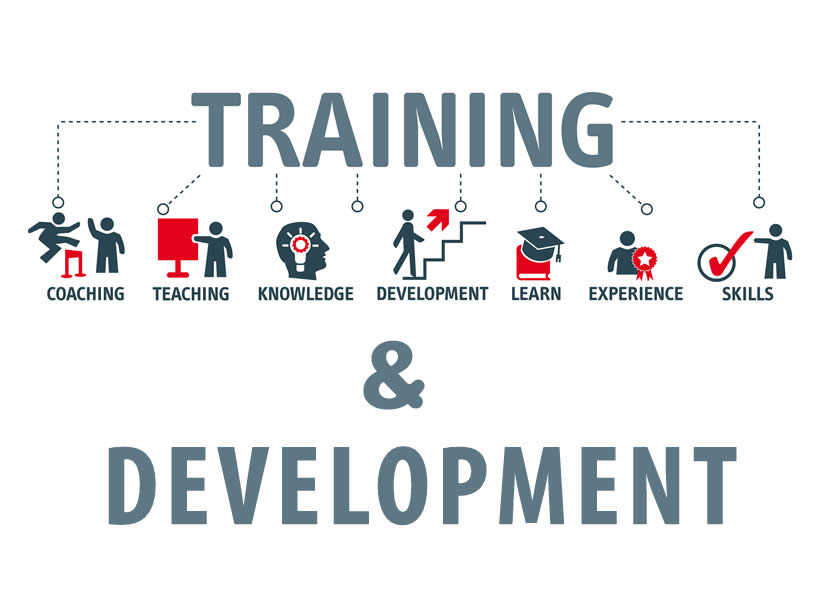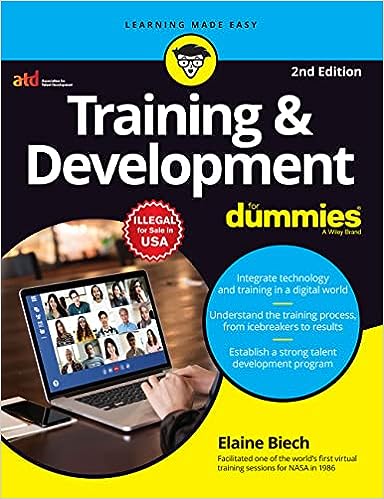
Meaning & Definition of Training
Training is one of the most important aspects of human resource management, along with other tasks like recruiting, selection, remuneration, and manpower planning. Training is the deliberate effort to help workers develop the precise abilities, desirable behaviours, and information required to do their jobs well.
Training for new employees starts shortly after orientation. It is for non-managerial staff and is just for a brief length of time. It is crucial for both the development of the company and the success of the personnel.
“Training is the organised technique through which individuals gain information and/or skill for a specific goal,” says Dale S. Beach.
Edwin B. Flippo asserts that “training is an act of enhancing an employee’s knowledge and abilities for doing a certain profession.”
“Training is any endeavour to enhance employee performance on a presently held job or one connected to it,” claims H. John Bernardin.
“Training is the continual, systematic development among all levels of workers of those knowledge, abilities, and attitudes which contribute to their welfare and that of the organisation,” write Planty, Cord, and Efferson.
Feature of Training
1) Clear and Defined Dimensions: Training is a technique with certain dimensions. It has a clearly defined start and finish. Training exercises are planned such that the process itself moves and develops in an apparent and observable way. In a friendly manner, all of the training’s activities are organised.
2) Planned Sequence of Events: Training is a planned set of tasks that enable the learners to carry out previously untried actions. The programme, which has specific learning goals, supports the whole process.
3) Makes Optimal Use of Opportunities for Learning: The practise of giving workers plenty of opportunity to learn and develop may also be seen as making the most use of learning opportunities. It seeks to increase employee enthusiasm by honing their abilities to do a certain activity.
4) Encourages Behavioural Changes: By giving workers new abilities and enhancing their performance, training helps to improve employee behaviour. It aids in enhancing the social and personal lives of workers, which raises the calibre of their job and promotes self-improvement. As a result, it broadens the scope of its usefulness much beyond the workplace.
5) Increasing Capacities: Training is not only about learning a certain ability to carry out a specific activity; it also involves the growth of a person’s total capabilities to handle complicated circumstances and issues. To effectively complete the assigned assignment, a trainee should be aware of how to improve and adjust his talents and knowledge.
6) Examining the Inner Self: The training’s most crucial feature is that it not only enhances already-existing abilities but also reveals the workers’ latent talents and inspires them to work hard. It informs the employer of their assets and liabilities. Additionally, it tries to assist workers work on their areas of weakness, which promotes self-improvement and progress.
7) Removes Mental Blocks: Training assists in removing trainees’ doubts and concerns about their jobs, enabling them to put out their best effort to fully use their potential and skills.
8) Produces Both Intended and Unintended Results: Training aids not just in reaching expected results, but sometimes it also yields several benefits that were not deliberately intended to be obtained. Depending on the sort of training, the advantages might differ from organisation to organisation and from person to person.
9) Establishes a Connection Between Theory and Practice: Training enables trainees to connect their newly gained theoretical knowledge with its application in the real world. This is made possible by training since it informs staff members of how to put their newly acquired skills to use at work.
Check here for latest case studies and research book : https://kit.co/Anurooba/case-analysis-text-books
Scope of Training
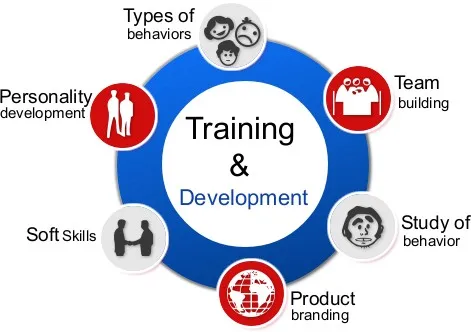
1) Training in Company Policies and Procedures: The first thing management does after hiring new workers is to acquaint them with the company’s culture. The company’s customs include the procedures to be followed, the individuals they must work with, their bosses, coworkers, working conditions, etc. However, this training has the problem of perhaps having little effect on an employee’s capacity to build faster organisational processes.
2) Training for Specific Skills: Training for Specific Skills primarily focuses on the development of any special abilities of an individual connected to his work. Introducing applicants who have just been hired to sales, manufacturing, mechanical skills, etc. By creating a person proticient, this training’s primary goal is to assure that person performs significantly.
3) 2) Training in Human Relations Skills: Human relations skills training has a significant beneficial effect on both the organisation and the people who get it. This training procedure emphasises on treating workers like people rather than as machines and strives to change their viewpoint and behaviour in order to enhance and make the workplace more pleasant.
The workers’ interpersonal skills and capacity for self-learning are improved by this training, and it also boosts their productivity, which raises the organization’s overall productivity.
4) Problem-Solving Skills Training: As the name implies, this training is utilised to address a variety of organisational issues. Many organisations use this training approach, wherein all of the managers and supervisors from various branches or departments are gathered in one location to discuss the relevant issues and potential solutions.
When they all get together, they not only search for the best answer but also share ideas and perspectives that might later be beneficial for the organisation.
5) Training in Managerial and Supervisory Skills: If a company recruits employees for managerial or supervisory positions, the management will undoubtedly favour applicants who possess the specific set of skills needed for the position. Managerial positions need both technical and theoretical understanding.
Because of this, many businesses educate their staff members in the fundamental management duties of staffing, planning, organising, leading, and managing. In addition, those hired for the position of supervisor get training in areas such as manufacturing, finance, human resources management, and operation management.
Need for Training
1) Align employee qualifications with work needs: An employee may not precisely fit the demands of the position or the company. He could have the necessary credentials in terms of the relevant degrees or experience, but the organization’s needs might not match the workers’ current skill sets. To close these significant knowledge gaps and enable workers to carry out their jobs effectively, training is necessary.
2) Process of organisational sustainability and transformation: Every organization’s fundamental goal is to endure in the market over the long term. But a variety of circumstances may affect an organization’s existence. In order to maintain its market share, the organisation must adjust to changes in the environment in which it operates.
Employees must be competent enough to contribute to the organization’s creative practises in order for productivity to rise. Only by giving the staff the appropriate training will it be possible. Training aids in the creation and efficient operation of organisational processes.
The efficacy of the transformation process may be developed to increase organisational productivity. This can be done by improving the workers’ current level of skills and knowledge, which can be done by providing them with enough training.
3) Technical Advancement: Organizations nowadays often update their technology, such as via mechanisation, computerization, and automation. Organizations risk becoming outdated in the long run if they do not accept the current way of functioning. On the other hand, using technology alone won’t provide greater outcomes; you also need the people who will be in charge of administering and using the technology. The best way to improve these people’s talents is via training.
4) Complex Organizational Structure: As new technology enters the contemporary industrial sector, the organisational structure is getting more and more complicated. Employees must be better able to adjust to the most recent organisational structure.
Organizational effectiveness can only be attained by giving workers the essential training they need to be change agents throughout the whole process of bringing about organisational effectiveness.
5) Job Profile Modifications: Promoting or moving an employee from one role to another is a fairly regular procedure. Additionally, it’s possible that the employee may get a new position with new duties as a result of a promotion or transfer. Such staff need to be trained in order for them to carry out their duties efficiently in the long term.
6) Friendly Employee Relations: The management’s attitude toward their staff has undergone a significant transformation. The day when workers were only regarded as one of the manufacturing inputs is long gone.
Maintaining positive relationships with workers is now essential for every organisation to be successful in the market on all fronts, in addition to other crucial elements. Employees that get training are more prepared to handle issues and maintain a positive work environment.
Purposes of Training
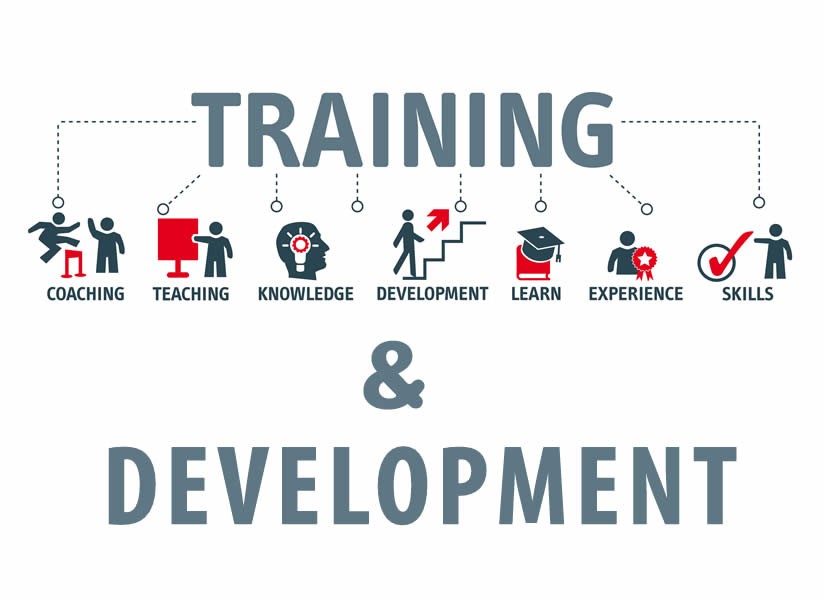
1) To Improve Employee Efficiency: Training attempts to improve employee efficiency by providing the skills required to do the work in a more effective manner. It narrows the performance gap between what is achieved and what is wanted.
2) To Improve Employee Skills: Organizations must maintain a careful eye on the many activities and changes taking place in their surroundings in this constantly evolving world of technological innovation.
In this situation, it is even more important to maintain the employee well equipped with the knowledge and skills required to do a particular work. To keep an employee current and adapt to technological developments in line with the organization’s processes and procedures, training is crucial.
3) To prevent or delay managerial obsolescence: If managers do not take the effort to accept the most current technological developments, it will be seen as a failure on their part to keep up with the environment’s changes. The performance of the organisation is likewise lowered by this failure. Therefore, training seeks to prevent this scenario in the workplace.
4) To Prepare Employees for Higher Positions: Training normally seeks to prepare the employees to manage greater responsibilities by instilling extra skills necessary for the completion of a difficult assignment. Employee confidence is boosted, leading to higher performance.
5) To Lower Employee Turnover: Training attempts to lower employee turnover by simply igniting their passion and inspiring them to carry out their duties proficiently. Employees may relax about their professional progression at the same time.
Training revs up and renews workers’ commitment to the company. Therefore, managers have a responsibility to support appropriate training initiatives, particularly for talented staff.
6) To achieve organisational excellence: Training improves workers’ current abilities, which leads to greater performance, a lower accident rate, fewer machine malfunctions, and ultimately, a more competitive organisation with a trained workforce.
Through the development of a pool of educated and competent workers who can assist the organisation in managing its competitive edge, all these aspects improve the sustainability of the organisation.
Types of Training/Training Methods
1) Induction Training: Also known as orientation training, induction training aims to acquaint new hires with the company and its culture. They benefit greatly from this training since it helps them feel at ease and integrate into the organization’s culture fast.
With this training approach, new employees are exposed to the company’s aims and objectives, laws and regulations to be followed, tasks they are expected to do, expectations placed on them, policies they are expected to implement, etc.
2) Competency-Based Training (CBT): This kind of vocational training trains participants in accordance with the organization’s criteria. Instead of concentrating on personal growth, it looks at how well a person performs at work after receiving the appropriate training. It gets new hires ready for any future contests they could encounter.
3) Knowledge Training: Any employee working for a firm must get adequate training on the tasks they will be doing. Thus, new hires get knowledge training to increase their expertise and comprehension of any specific organisational problem.
This kind of training not only encourages workers to perform better, but also aids in retaining a more attentive and efficient workforce, further preparing the company for numerous contests.
4) Skills Training: Throughout a person’s whole employment with a firm, there are a few fundamental skills that are necessary. These abilities, including self-management, coordination, leadership, calculation, and communication, are taught in the workplace via lectures, seminars, counselling, apprenticeships, and a variety of other approaches. In organisations, this sort of training programme is fairly prevalent.
5) Cross-Functional Training: This kind of training is often provided to staff members who can readily take on the duties of other departments. There are a few ways to provide this kind of training to the staff, including job rotation, in which the staff is required to carry out various tasks within the same functional area in various parts of the organisation for a set period of time in order to gain an understanding of how other departments function. In addition to this, top performers may instruct other staff members on how to do certain departmental tasks.
6) Team Training: This sort of training includes two fields: content tasks and group procedures. “Content tasks” are intended to define the team’s goals, such as cost control, revenue generation, and problem-solving, etc.
While the goal of “group processes” is to show how the group members communicate, operate as a team, and settle problems, etc. Organizations use a variety of training techniques, such as experiential learning, to foster a sense of camaraderie among the team members.
7) Creativity Training: In today’s cutthroat business environment, every organisation requires creative and knowledgeable people. Organizations look for individuals that have the greatest creativity and who think beyond the box. As a result, the corporate sectors utilise a variety of brainstorming approaches and creativity training methods to impart such training to new workers, making them innovative, knowledgeable, and capable of delivering great performance.
8) Diversity Training: Diversity training aims to increase employee knowledge of cultural diversity and how to create good working circumstances in a multicultural workplace. Employees that get this kind of training are better able to handle the problem of cross-cultural sensitivity.
Training Techniques/Methods

The organisation invests a lot of money each year on its workers’ training and development. The organization’s major motivation for doing this is to increase staff productivity by raising their level of competence and knowledge. There will always be a need for training since it is quite unlikely to always find the best qualified and experienced candidate.
Therefore, training is given to the personnel utilising a variety of training techniques in order to make them skilled. These training techniques encourage workers to advance their abilities while also putting them in a position to fulfil future organisational needs. As a result, businesses use a variety of training techniques. Here are a few of them:
On-the-Job Approaches/Methods
Learning by doing is the foundation of on-the-job training methodologies. This approach places trainees in actual work environments so they can do their duties. They are given sole authority to resolve problems on their own in some circumstances, and this is how they learn by doing their work.
Additionally, new hires learn what has to be done from more seasoned workers and develop their talents under their direction. The majority of organisations now use this kind of training methodology due to its growing popularity. The following is a discussion of several essential on-the-job training techniques:
1) Job Instruction Training (JIT): During this training procedure, each learner is given a set of instructions one at a time. These instructions are provided by skilled instructors who are familiar with the methods and processes to follow as well as the duties that must be carried out on the job.
In this teaching strategy, students first watch their teachers do the work before copying them and finishing it independently. This makes it easier for the instructors to identify and quickly fix any mistakes made by the students.
2) Apprenticeship: This practise adheres to the tenet of “earning while learning.” In this approach, a knowledgeable and skilled individual imparts his or her knowledge and abilities to the student who wants to master that ability. After completing the apprenticeship programme, the trainee may apply for a permanent position, if any are available.
3)Job Rotation: This is the procedure through which workers are given the chance to work in different divisions within an organisation. The workers receive fresh information and expertise about the various tasks carried out by various persons in the organisation when they rotate from one department to another or from one division to another.
Job rotation occurs either via promotions, when workers move from a lower level to a higher level, or through lateral transfers, where only the employee’s position is changed; the job responsibilities remains the same. Therefore, using this training approach is the most effective technique to turn a worker into an expert.
4) Coaching: Coaching is the act of providing direction to subordinates by superiors in an organisation. Along with serving as an unofficial and impromptu teaching technique, it strengthens the relationship between subordinates and workers.
The senior management coaches or instructs the staff members on how to complete the assignment and how to fix errors that have been made. Later, they assess these workers’ output as well.
5) Understudy: This strategy involves training the trainee to carry out the duties of his trainer or to eventually hold the position of his superior. According to this strategy, the employee who had training under the management or superior would be given his or her job when they are going to leave the company due to transfers, resignations, retirements, etc. In contrast to coaching, this strategy allows the manager to choose one employee from his department to serve as an understudy.
6) Mentoring: In this approach, instruction is provided by a knowledgeable and experienced individual. In organisations, mentoring is often carried out by senior personnel who want to develop the talents of less experienced workers. Many businesses utilise mentoring as a nurturing technique to develop their workers’ knowledge and skills.
A BEST WAY TO EARN WHILE YOU STUDY, JOIN THIS APP UPLOAD PHOTOS, SAVE MONEY FROM NOW ON : https://bit.ly/3g7PxAg
Off-the-Job Approaches
Off-the-job training approaches, in contrast to on-the-job training approaches, adhere to the principle of “learning by obtaining information” rather than the idea of learning by doing. With this approach, the students are called upon in a classroom that may be located within the business or somewhere else, like a centre or an institution.
Due to the remote setting, the trainee may study without the pressure of job duties. This advice’s primary goal is to increase the new hires’ expertise. Following are a few popular off-the-job training techniques:
1) Lectures: The lecture approach consistently shows to be the most effective way to explain concepts, ideas, and hypotheses to trainees when imparting technical knowledge to new hires.
It is a one-way communication technique in which the mentor gathers all pertinent information for the students and delivers a lecture utilising different teaching tools like models, chart paper, visual aids, audio aids, etc. As a result, it is the most straightforward approach of educating the trainees.
2) Simulations: This training technique simulates a real-life scenario of the work that may have occurred in the organisation in the past, such as damage to any priceless items, a major investigation that would have negatively impacted the firm, a costly error, etc. The trainees may be given a number of actual examples to help prepare them for how to respond to various scenarios.
By doing this, the organisation gives the trainees the opportunity to learn about potential workplace occurrences and how to handle them. This approach is employed in fields like the aerospace sector where on-the-job training may be costly or harmful.
3) Case Study: With this approach, actual business scenarios are framed and given to trainers. Students are required to debate it and provide their suggestions on how they may have handled the circumstance. This approach, known as the case study technique, is one of the most popular methods to teach using real-world business scenarios.
4) Role-playing: In this technique, trainees are given a hypothetical or actual issue that typically relates to the organisation. They must act as if they are in that specific position and take the persona of that specific individual. Employees might utilise a variety of visual aids and advice provided by their mentor while carrying out their performance to improve their managing abilities.
5) In-Basket Exercise: Using this technique, the trainee receives all the pertinent documents required by management, such as letters, reports, records, etc. A particular circumstance that managers encounter often is presented to the trainee. He is required to evaluate the scenario, prioritise the items, provide justification for his choices, and make a final judgement on the topics brought up throughout the exercise.
The activity provides the management with a quick view of the learner’s executive function and role performance. The whole process is captured on film, and the concerned applicants are evaluated according on a predetermined set of skills and talents, including problem-solving aptitude, time management, etc.
6) Conferences: A conference is a systematic means of presenting ideas to a sizable audience that is present at the event. Experts from various professions gather to discuss a shared issue and, if necessary, have any questions they may have answered.
7) Seminar: Another name for a seminar is a “Seed Plot,” which refers to it as a starting point for learning. These are led by knowledgeable and experienced individuals who not only prepare the discussion topic and present it to the students, but also assist them in exchanging ideas and exploring their perspectives on the subject. Because it is narrowly focused on a single subject, students are better able to comprehend the material and react appropriately.
8) Group Discussion: This is one of the most often used training techniques. In this approach, the group of trainees is given a subject and invited to actively engage and provide their perspective on the problem.
The discussion subject is chosen on the spot, so there is no time for preparation, but this also increases interest and passion among the trainees since they may prepare the issue. This approach not only assists in problem-solving relating to the exchange of beneficial experience but also in gaining fresh insights and subject-specific information.
9) Sensitivity Training: It is obvious that this involves understanding feelings and sentiments since the term “sensitivity training” is connected to training. It is also known as laboratory training or T-group training. Assessment based on “one for the other” behaviour. The purpose of this training is to help the participants understand and appreciate one another’s sentiments and emotions.
Syndicate training has shown to be a highly effective way for training top management. The workers form a group and work together throughout the training process to carry out any specific task. This approach involves several groups cooperating to meet the organisational training objectives.
11) Simulation: Simulation is a teaching technique that simulates real-world situations by having students create replicas of as many real-world variables as they can. making choices that produce consequences similar to what would occur in the workplace.
The aircraft sector has made the greatest use of simulation technology. This training is crucial in situations when true on-the-job practise may lead to a significant question, an expensive mistake, or the ruin of a synthetic, risk-free setting. They are used to instructing in both production and process abilities as well as managerial and interpersonal choices.
Advantages & Disadvantages of On- the-Job & Off-the-Job-Training
| On-the-Job Training | Off-the-Job Training |
| ADVANTAGES | |
| 1) No extra cost is incurred as training is given in normal office setting and by the same officials. | Plenty of time is available for training to take place. |
| 2) Proper teaching methods are not needed. | Individual attention can be given to trainees’ problems and areas of improvement. |
| 3) Instead of replicated work settings, actual situation is given to trainees to work upon. | Favourable for learning as the atmosphere is calm and stress-free. |
| 4) Trainees become familiar to job setting right from the beginning. | No scope of disturbance is there; hence trainees can feel more concentrated. |
| 5) It proves fruitful for the organisation as trainees also contribute in departmental works. | It is less risky to implement ideas and suggestions given by trainees, as it is done on simulated work settings. |
| 6) Training can be steered as per the current needs. | It inspires the trainee to work upon their own growth and development. |
| DISADVANTAGES | |
| 1) It is difficult ti identify the cost incurred in training. | Cost is incurred in various external arrangements |
| 2) Due to actual job setting, threat persists to machinery and other office equipment | Trainees cannot get acquainted wit actual jobsetting and the real work situations. |
| 3) Training may not be very effective as it is not imparted ny any professional trainer. | It might be challenging to create a replicated work environment |
| 4) Less time is given to trainees as the employees also need to tackle their routine work simultaneously | Trainees might face issues as they have to stay at some other place. |
| 5) It is difficult to adjust with some odd, irregular, and unconventional characteristcis of trainees. | It might be problematic for trainees to apply their training knowledge in actual work settings as they are being trained in stimulated settings. |
| 6) Trainees might feel pressurised in working among experienced employees. | It is a time-taking process and involves various additional expenses. |
Difference between On-the-Job & Off-the-Job Training
| On-the-Job Training | Off-the-Job Training |
| It is an economical method and can be conducted at a lower cost. | It is the non-economical method and requires separate investment for training rooms, trainers, tools and equipment or the training process. |
| Under this training method, employees are trained while working in the organisation. Thus, productivity is not affected. | Under this method, employees are taken away from the job pressures and thus, there is no productivity during this period. |
| This training method provides quick results as new employees start performing their functions as soon as possible. | The new employees may need to acquire the qualification first and then they are allowed to perform their function. |
| The training process may get disturbed due to disruptions created by people or machines | There is no chance of disturbance as the training process takes place far away from the organisational enviornment. |
| Examples of on-the-job training methods are job rotation, apprenticeship, mentoring etc. | Lectures, conferences, group discussions, case studies are examples of off-the-job training |
| The working of the trainees is observed by the top management or the supervisors | Trainees acquire knowledge and guidance under a well-experienced and specializes instructor. |
Process of Training
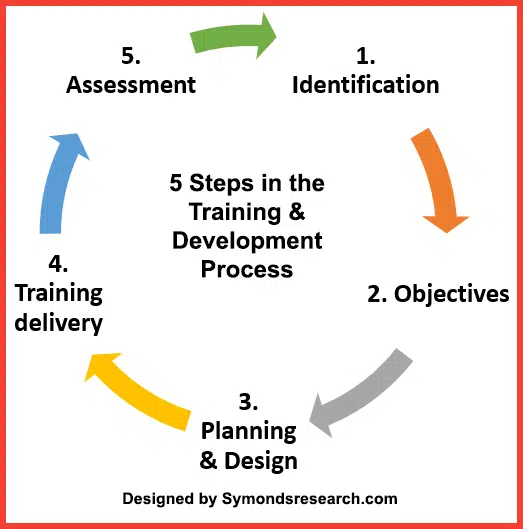
In order for the training to be effective, there are a number of procedures that need be carried out methodically.
1) Evaluation of Organizational Objectives and Tactics: It’s critical to evaluate the organization’s goals and strategies before beginning the training process. Organizations should have a clear understanding of their company objectives, plans, and vision. The organisation won’t be able to evaluate the strengths and weaknesses of its staff unless all of these factors are known.
2) Evaluation of training needs: Various training and development programmes cost a lot of money in many organisations. But unless the management is aware of the necessity for these training programmes, such a large investment in these procedures is pointless. Therefore, it is important to determine what kind of training is needed to prepare the workforce for both current and future business difficulties.
3) Setting Training Objectives: Setting training goals is important because without them, no training programme can be created and its efficacy cannot be assessed.
As a result, after determining the training requirements, it is essential to design an obvious and measurable training aim that the workers can readily comprehend. Even if each person’s attitude is unexpected, putting up a particular standard might nevertheless assist the organisation get the outcomes it hopes for.
4) Creating a Training and Development Program: The process of creating a training programme begins when the objectives for the training series are decided. It serves as the cornerstone of an effective training and development programme. For this, the most knowledgeable and specialised teachers are chosen, and they look for the program’s most relevant material.
There is a quick overview of the complete programme followed by information on the necessity for the training, its potential benefits for the participants, how the training would affect the development of their skills, etc.
5) Training Program Execution: Now that the instructional programme has been designed, it is time to put it into action. When conducting training, a company must first look for a central location where the trainees can be contacted before making further preparations about scheduling, location, etc. Finally, the programme is carried out with the assistance of experts, and the supervisors monitor the trainees’ development.
The trainers hired for this programme should be well familiar with the program’s goals and working conditions. He should be proficient in both communication and creativity. However, putting any training programme into action is a difficult undertaking that often leads to issues. Sometimes the issue is with the management since they don’t want to invest their time on such training programmes, which makes it quite challenging to locate qualified teachers.
6) Evaluation of Outcomes: Because an organisation spends a lot of money on the training and development process, the effectiveness of the results has a big influence on the productivity of the organisation.
The major purpose of evaluation findings is to determine whether or not the training process has shown to be beneficial to the workers and the organisation. The performance of the workers and the organisation as a whole is improved by systematic evaluation, even though many organisations treat this procedure extremely laxly.
Advantages and Importance of Training
1) Reduction in Production Expenditure: Employee training enables them to complete tasks as efficiently and effectively as possible. It leads to the best possible use of the organization’s resources. This aids the organisation in reducing costs associated with rework and unethical practises.
2) Decreases Risk of Accident: A trained individual utilises equipment extremely well since he has been instructed to use it to its maximum potential, which deters accidents and other calamities.
3)Stability in the Organization: Training makes workers more productive. This enables the organisation to release the person in charge of their supervision. Additionally, it increases the workers’ self-assurance as they work diligently and without tardiness.
4) Increases Employee Confidence: Trained employees are capable of doing their duties properly and easily comprehending the processes and methodologies. Employees so acquire self-assurance and begin to perform to their maximum ability in order to achieve job happiness.
5) Higher Levels of Quantity and Quality: Training improves manufacturing of things in big quantities that are also of higher quality.
6) Determining Efficient and Inefficient Workers: Training makes it easier to tell the difference between an efficient and inefficient worker. With the aid of training, it is simple to distinguish between people who learn and do things fast and those who do so more slowly.
7) Minimum Requirement for Supervision: If a skilled individual is operating equipment, no supervisor is required since the employee is competent enough to do the task at hand.
8) Beneficial for Managers: When managers are relieved of the burden of supervision, it is simpler for them to concentrate on other crucial challenges facing the organisation.
9) Increases Ability to Grasp: Training helps the individual understand the process in which he is engaged. One can do the method more effectively if they are able to comprehend the technical intricacies on their own.
Limitations of Training

While carrying out any training programme, an organisation may encounter a few issues. The following are a few of the problems:
1) Lack of Corporate Commitment: One of the major issues faced by many businesses is a lack of organisational commitment. The majority of businesses have little interest in spending money to teach their lower-level personnel. If they spend money on training and development programmes, they should ideally be at the highest level.
2) Competitors will Tempt Trained Workers: Many small-scale companies attempt to avoid providing employee training because they are concerned that once the employees’ abilities are enhanced, they may start looking for better employment prospects or they may start demanding higher compensation and positions. As a result, the management jeopardises the workers’ advancement for their own gain.
3) Expensive for SMEs: Small and medium-sized businesses cannot afford to provide these programmes for their workers because of the significant costs involved. Sometimes the COSE incurred is too high for these small and medium-sized businesses to bear.
4) Handled as Expenses: The majority of the time spent in a training process is treated as a cost rather than an investment, according to the guidelines of the comice department. Such a mindset in these organisations not only deters trainees but also severely affects the expansion of the whole company.
5) Lack of Financial Assistance from Government: It is quite challenging for large organisations to run any sort of training programme for the improvement of their workforce when the government does not provide financial support for whatever reason. As a result, the advantages of training are not adequately used, which in turn prevents employees from developing.
6) Limited Supply of Skilled and Employable Graduates: Organizations sometimes have to make difficult arrangements since training is becoming more time- and money-consuming. training programmes to educate workers even the most fundamental skills. In these situations, training programmes are
7) A lack of cooperation between institutions and industry: There is a direct link between academic institutions and the industrial sector since contact between the two may serve as the best means of exchanging necessities. Companies, however, are unable to express the skills and competencies that workers should possess because of the absence of this coordination.
Resistance to Training
For many trainers in the corporate sector, resistance to training is a significant barrier. Trainers use the word “resistance” to describe workers that are reluctant to acquire new information, concepts, or behavioural patterns. To be successful, employee training is crucial.
Despite the importance of training for both the success of a person and an organisation, both managers and workers often oppose it. They may claim that training is merely distracting them and has nothing to do with them being better at their jobs. However, it is the trainer’s duty to instil in them the understanding that training is a crucial component of their work.
The following is a discussion of several training resistance sources:
1) Group Resistance: If the group’s goals are thought to clash with the training program’s goals, anybody who cooperates with the trainer is seen as a traitor. For instance, a collaborative initiative to increase efficiency can be blamed for layoffs inside the company. Employees may jointly oppose the programme in certain situations, and this should be dealt with as follows:
i) By addressing the problem head-on and not sidestepping it.
ii) When there is no reconciliation, by dealing with the opponents.
iii) By not assigning blame to a specific individual.
iv) By highlighting emotions and viewpoints and demonstrating that some individuals could be having issues.
v) By demonstrating concern for the complaints of workers.
2) Resistance to Change: People will first find it very difficult to accept completely new ways since they are used to doing their job in a certain manner. In such cases, the following tactics may be used to overcome reluctance to change: people should make modest modifications.
1) Encouraging
ii) Encouraging kids to try and acquire new abilities without worrying about being made fun of.
iii) Determining the cause of opposition and promoting discussion of the issue.
iv) Doing the new activity firsthand while soliciting feedback.
v) Gathering and disseminating people’s good opinions.
3) The Fear of Seeming Stupid: The innate fear of looking foolish in front of others may prevent someone from attempting a new thought or habit. People could be discouraged from using more effective work practises due to their fear of shame. The following tactics may be used to deal with this circumstance:
i) Realizing that taking risks is necessary for success.
ii) Preventing a hostile environment inside the organisation. iii) Maintaining a fun and upbeat culture without putting pressure on staff.
4) Uncertain Goals and Objectives: Insufficient training, especially when their training has limited applicability or the solutions for dealing with this scenario in their profession. They might stop participating in the Goals. In general, plenty of people get little to no information on training goals. In such a circumstance, people may act aggressively, go on autopilot, or stop responding, which would have a bad effect on others.
i) Discussing the issue with the participant and stressing the need for them to find a solution.
ii) Promising to assist with their issue by integrating their educational need with the programme and enabling them to converse with others about their experiences.
iii) Making an offer to assist later on if their current issues can’t be handled right now.
iv) Renegotiating the learning program’s objectives and changing them to align them with the students’ goals. If it’s not practicable, people should at least be given the chance to voice their opinions.
Other Related Topics:



